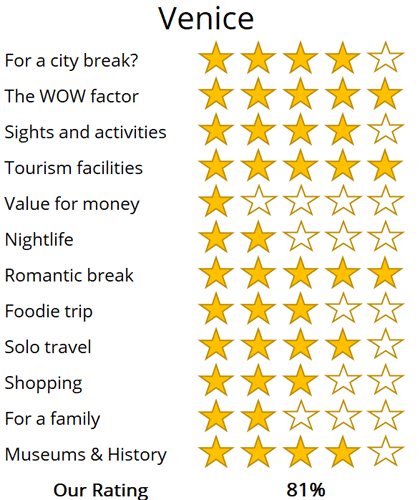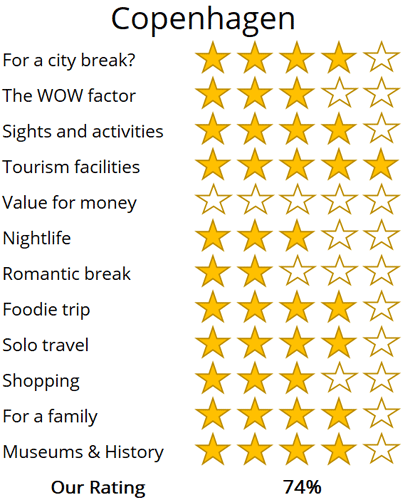WhereToGoForMyHoliday.com
The best destination comparison site!
WhereToGoForMyHoliday.com
The best destination comparison site!
Venice or Copenhagen, which is better for your holiday in 2024?
Venice and Copenhagen both offer unique and enticing experiences, but which one should you choose for your city break or holiday?
We understand your dilemma. There is an abundance of travel guides for both cities, but few actually comparing them, and advising you which is the better for your trip.
This article will provide our unbiased and independent views of Copenhagen and Venice, hopefully making your choice that little easier.
The article is structured into several sections, each of which can be directly accessed through the following links:
• Introduction to the cities
• Scores and ratings
• Which one should I, friends, or family visit?
• When to visit and weather
• Who is the city suited for?
• The perfect 48hours (with map)
• Tourism details (where to stay? airport details?)
Introduction to Copenhagen and Venice
Ah, Venice – a bucket-list city if there ever was one! Famed for its myriad canals, vast plazas and grand churches, this is one of Italy's most visited destinations. Once the epicentre of its own trading empire that stretched right across the Mediterranean and even east to the Old Silk Road, it became rich on spices, precious metals, and cloth.
These days, relics of that golden age remain. See them rise with the Orientalist spires of Saint Mark's Basilica. See them in the opulent interiors of the endless Doge's Palace.
But Venice is still a thriving town, not just a museum piece. Ferry boats weave through the Grand Canal and under arches where Canaletto and Monet once painted. Ice-cream parlours spill onto the narrow streets of Cannaregio.
Pizzerias meet buzzy student bars scented with grappa around the Campo Santa Margherita. Yep, there's oodles of life left in this old seafaring dame!

The Campanile di San Marco in Venice
Sleek yet historic, gritty yet creative, Copenhagen fuses all the contradictions of Scandinavia in one outstanding city.
Yes, it's pricy. But your money buys quality in these parts, whether that's the crispy Danish pastry in the morning, the single-origin coffee beans, or those craft beers in the independent drinkeries.
Once the home of Hans Christian Andersen, the city's Indre By – the historic core – is all weaving cobbled lanes and flower-strewn cottages from centuries gone by. Meanwhile, over in districts like Christianshavn and Vesterbro, there's a buzz and energy about proceedings.
Don't forget that this capital is the veritable home of New Nordic cooking, putting foraged foods and mind-boggling flavour combos front and centre…

The canals and traditional houses of the Nyhavn district (Copenhagen) are always a favourite with tourists
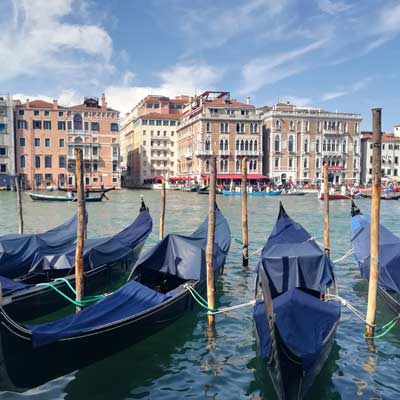
Grand Canal and gondolas waiting for the rush of tourists
Copenhagen vs Venice: City Ratings
Summary
Where would I journey for a personal escape?
Copenhagen
Where would I send my parents for a memorable visit? Venice
Where's the ideal destination for my adventurous 19-year-old cousin?
Copenhagen
Where should my food-obsessed friend indulge their culinary passions?
Copenhagen
Note: The above comparisons are weather-independent and are based on travel during the most opportune times of the year. Details about the ideal travel seasons are elaborated upon later in this article.
In the sections that follow, you'll find a comprehensive comparison between these two fascinating cities. This includes recommendations on the duration of stay, the best times to visit, and tailored 48-hour itineraries for each city.
The final segment delves into practicalities for your travels, such as the best airport to fly into, the optimal districts for your accommodation, and insider tips, for when you come to explore the city.
We hope that you find all of this information useful, in planning your next exciting trip!
Destination details
How long to spend each city?
It's no secret that most people whiz in and out of Venice on big cruise ships, even if recent regulations are bringing a slow end to that.
Lots of weekenders also come on low-cost flights – Venice's Treviso Airport is a major hub for budget airlines like Ryanair and Easyjet. Those sorts of travellers can only ever really expect to scratch the surface of what's on offer.
The upshot? If you really want to explore this amazing city, you're going to need a little longer. If the budget allows, a week is perfect. That will be enough to see the mainstay sights, but also venture across to Murano and the Venice Lido, the party bars of Campo Santa Margherita, and the pathways of Giudecca.
There are two sides to Copenhagen. There's the side that most visitors will aim to see, and that's all neatly packaged up for a quick two- or three-day break. Then there's the more local side. That can take weeks, or even months to enjoy to the fullest.
The upshot is that everything from short fly-in city breaks to longer jaunts are doable in the Danish capital – there's enough to keep you going, provided you've got the money to keep going!
In addition, it's worth thinking about what out-of-town excursions you might want to do from Copenhagen. These will inevitably add some time to the trip but are also downright tempting.
The likes of the ancient Viking capital of Roskilde, and the Swedish city of Malmo, are both on the menu.

The Arsnal was the shipyard of Venice, which at its height could construct a boat in a single day

Tivoli Gardens theme park, in the centre of Copenhagen is the second oldest theme park in the world, and was original constructed in 1850 with the aim of "when the people are amusing themselves, they do not think about politics”
Copenhagen's weather often surprises visitors, being neither as bleak as they may assume nor as cold as it is frequently lumped together with its neighboring Scandinavian countries.
Summer is Copenhagen's most beloved season, and the city emerges from its casing of snow and ice to become a real outdoorsy gem. In the capital, this means the canal-side cafes of Christianshavn come alive with al fresco drinkers, and the breweries expand into leafy gardens. This is also the time to enjoy the famous Brygge Harbour Bath and the other marina swimming spots in full swing.
Spring and autumn are good alternatives, particularly if you're on a tight budget. Already high prices can soar in Copenhagen during the summer months.
Winter offers its own charm, peaking around Christmas when the Tivoli market fills the air with the aromas of gingerbread and spiced wine. January, although cooler, is more economical and often adorned with a captivating blanket of snow.
We're almost tempted to say forget Venice in the summer entirely. During the Italian high season between May and August, the whole place is packed to bursting with tourists. You can barely swing a slice of pizza on the Rialto Bridge or down on Piazza San Marco.
What's more, the horizon is tainted with the outlines of huge cruise ships.
Far better are the shoulder months of May and September. The crowds diminish considerably during those, but the weather still tends to be reasonable – think daytime temperatures regularly hitting the mid-20s.
The final weeks of February are also popular on account of the centuries-old tradition of the Venice Carnivale. Come then to join the revelry but be sure to bring along a flamboyant face mask (a must) and a good coat, because the winters can be cold.
It's probably a good idea to avoid the rest of the winter. Venice is one of the lowest-lying cities in the world, so flooding comes easy. In the last few years, there have been huge problems with water clogging up even the famous tourist hotspots around Piazza San Marco.
Venice is a perfect break for those keen to check off another bucket-list city. Yes, it might be over touristed, but there's still something truly magical about the canals and the gondolas and the great churches here.
It's simply unlike anywhere else on the planet. All that adds an edge of romance to boot. So, consider this one if you're searching for a city-based honeymoon.
On the flip side, Venice isn't for the budget traveller or the outdoorsy person. Yes, you can hop on a bus to go north to the Dolomites, but they are still several hours away.
There are beaches, but they are nowhere near the best on the Italian east coast. And you can expect to pay over the odds for virtually everything, from hotels to ice creams to pizza.
Copenhagen is tailor-made for creative, 30s-something city slickers. Bohemian cafes meet cutting-edge beer halls and restaurants that are breaking the mould, while workshops, design studios, and galleries cram the old town. If you're culturally engaged and enjoy places that fuse the old and the new, you could hardly do any better.
Copenhagen is famously expensive. Expect to pay around the 60kr mark (€8/$9) for a beer in most places – and even that's a decent deal! Hotels will cost a lot, no matter the season, and eating out is off the cards for anyone on a shoestring budget.
You can mitigate that if you picnic and dodge the pubs, but it's not really the place for travelers watching the pennies.
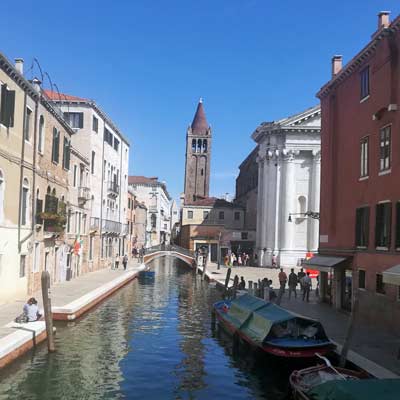
The pretty Ponte dei Sospiri and canals of Venice

Grand Rosenborg Castle, was built as a summer residence by Frederik II in 1624, and today houses the royal treasury and displays the Danish crowns
48hours in Venice
Delve into the secrets and the uber-famous sights of Venice with this 48-hour itinerary. It will take you from the legendary walks of the Rialto Bridge all the way to the hidden glass workshops of Murano, revealing some of the most enthralling corners of the iconic City of Canals.
Day 1: Rise early and race to the Piazza San Marco. Beating the crowds to the vast plaza is a great way to see it in all its glory. As the sun rises, watch as the light caresses the red-brick Campanile (a 98-meter belfry dating from the 12th century) and the bulbous domes of St Marks Basilica.
If you've managed to arrive before the queues start to form, be sure to duck into the latter. It's free to enter and has intricate Byzantine apses and frescos. Right next door is the Doge's Palace. Again, if it's too late you can certainly expect a queue. If not, head behind the Gothic frontispiece to wander the old palace of the erstwhile leaders of the Venetian republic.
Then head north through the narrow alleys of the San Marco district. It's a beautiful maze of little side streets, occasionally punctuated by a watery canal. You're sure to find a cafeteria there for lunch, before you go straight for the Rialto Bridge, made famous by Shakespeare and painters. Cross it and hit the buzzing markets of Ruga dei Oresi, which abut the small Campo Bella Vienna, a top spot to sit with a cold beer and watch elegant Venetian gondolas drift in and out of the canals.
If you choose not to ride one, you can push on to see the San Giacomo di Rialto (probably the oldest church in the whole city!) and then the neighbourhood around Campo Santa Margherita. That's a nightlife mecca, where you can unwind with a prosecco or ten.
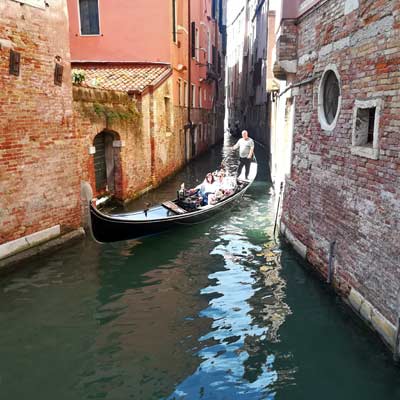
No trip to Venice is complete without a gondolas ride
Day 2: Your second 24 hours in Venice is all about hitting the different districts. We'd recommend starting on the northern side of the archipelago. That's home to characterful Cannaregio; the old Jewish Quarter. These days, it's got canal-side cafés next to the fascinating Muso Ebraico di Venezia, which tells the story of Venetian Jews over the centuries.
From there, move west to Santa Croce. Within, you'll glimpse the lived-in city. It's the only place where cars can travel on the archipelago and it has newer churches and loads of bakeries and shops. Hop the Grand Canal ferry (number 3) from there to Murano.
Pastel-painted workshops meet the water on that island, in an area that's been famed for centuries for its glass making. If you're interested, the Museum of Glass is a great place to start.
Alternatively, enjoy a lunch on the lagoon and then get back on the boat, travelling all the way through the Grand Canal to the Dorsoduro. The zone has beautiful broadside views of Piazza San Marco at sunset. It's also home to plenty of lovely osterias with northern Italian wines and delicacies to get stuck into.
Related articles: 48-hours in Venice

The vaporetti ferries are the best way to get a waterside view of Venice
Copenhagen offers so much for a fun-packed 48 hours. Below is an interactive tour map - day 1 is highlighted in green and day 2 in yellow.
Day 1: Begin the first day in the Rådhuspladsen, where the ochre-tinged walls of the City Hall dominate the skyline. This is a beating hub of the city, and you might find concert stages or markets taking place on the plaza. The bustling shopping street of Strøget starts here. Hit that to move between high-street retailers and lively pubs. The walk will take you all the way to Nyhavn.
This is a charming, historic area with 17th-century canals. The painted houses are a favourite with photographers, and you can opt to do a canal boat tour from the docks. Lunchtime is over in the Bridge Street Kitchen. Sprawling across Greenlandic Trade Square, it's a casual food mecca, with hotdogs mixing with falafel pitas and sourdough pizza breads.
Full? Good – Christiania awaits. This gritty artist community come squat is a unique bohemian commune. There are some pushy drug dealers and lots of tourists, but it's worth a stop. The spire of the lovely Church of Our Saviour is sure to pull you down to one end of the area, before hopping back over to Slotsholmen for a sighting of the grand Christiansborg Palace, the home of the Danish parliament.

The side streets of the Latin Quarter (Latinerkvarteret) are a joy to explore
Day 2: If it's sunny, there's never a better way to kick-off a day in Copenhagen than down on the marina. Free to enter and bustling with life, the Brygge Harbour Bath lets you swim in the refreshing waters of the Baltic Sea right in the heart of town.
Dry off and then grab a Danish pastry on your way up to the Indre By, where you can get lost in weaving lanes of cobblestone. The vast Rosenborg Slot sits at the far end of the district. A mighty palace from the 1600s, it's packed with art and can take a few hours to explore.
Nearby Torvehallerne will do nicely for food, with its array of local Scandi dishes. A hop across the water to hipster Nørrebro is great if you're craving a beer or a coffee – Brus is a good option.
Then head back south to Frederiksstaden district. It's crowned by the Rococo Amalienborg Palace, sports stunning churches, and buts up to the old town, where you'll find loads of bars and eateries to cap off the evening.

Christiansborg Palace is the Danish Parliament building along with the official residence of the Prime minister
Venice is largely safe and easy to travel. However, there are some things worth knowing before you go. First off, the overload of tourists has seen a huge spike in pickpockets over the years. So, always keep an eye on your valuables, especially in uber-popular spots like the Piazza San Marco and Erbaria.
Second, be wary that Venice's side streets are rarely empty. You'll always need to dodge a crowd and watch where you're walking. When it rains, flooding is common, so pack waterproofs and wellies if you're visiting in the winter months. Also, keep an eye out for pigeons. They're a nuisance on the piazzas and can even carry disease.
Navigating Venice isn't like navigating any other place in Europe. Taxis and buses simply don't exist – there are no real roads here, after all. Instead, you can make use of the ferries (known locally as vaporetti).
They run routes up and down the Grand Canal and out to other islands like Murano all throughout the day. They're actually a great way to see the main sights, with tickets for a full 24 hours costing as little as €20.

Rarely will you find a steet this quiet in Venice……
There are two airports serving Venice and its region. The largest and the closest to town is the international hub at Marco Polo Airport. That's got connections going all around the world. It's linked to the city by the ATVO bus (arrives at Piazzale Roma) and to the train station in Mestre.
If you're flying low-cost, it's more likely you'll arrive at Treviso Airport. That sits some 20 miles to the north, with buses that link to the archipelago in around 70 minutes for about €10 each way.
Choosing where to stay in Venice is very important. Fly-in, fly-out tourists will want to be in the vicinity of Piazza San Marco. The area is laced with expensive and classy hotels, but also has some more affordable options, all within walking distance of the top sights.
If to save some cash and get somewhere a little quieter, you could sleep closer to Dorsoduro or the Cannaregio, or even out in Murano. The cheapest places of all will be on the mainland, in Mestre.
Related articles: Where to stay in Venice?
The infrastructure of Copenhagen is amazing, and you will leave wondering why other cities struggle so badly…
The impressive and uber-efficient Kastrup Airport is the gateway to Copenhagen. A mere 6km from the center, you can hop from the terminals to the downtown by train in just 15 minutes or so. Use either the direct lines or metro links. Tickets are purchased on the station platforms and cost in the region of 36 DKK.

Copenhagen city hall and the Rådhuspladsen, the main plaza of the city
Copenhagen has many hotels and accommodation options, but the city has one of highest occupancy rates of Europe (a yearly average of 81%). That means booking early is key. We'd recommend trying to score somewhere in the Indre By area.
The old core, it's close to all the main sights. If you're on a tighter budget, going north to Nørrebro might offer a few extra deals. Meanwhile, the Vesterbro district is an up and coming area, which is trendy and a touch edgy. Frederiksstaden is a more refined and contains many of the smarter hotels.
If you want to get around like a real CPH local, then there's nothing for it but to rent a bike. These are cheap and easy to find in pretty much any area of town. A full day's cycling should cost around 150 DKK (£22).
Copenhagen is a very safe city, especially for a capital. People are often eager to help and there are good public services in general. Be more wary if you're venturing off the beaten track. Certain corners of Nørrebro and Christiania can be sketchy, particularly after dark.

oh we were stuck in the airport!

Copenhagen was a bit expensive...

All we did was drink beer in Brussels...

Muncih was crazy

And we got so burnt!

Remeber that night in Rome

oh we were stuck in the airport

So much fun kayaking

Berlin and that group from Austria!

There was such a view from that church

And we got so burnt!

Munich was eventful, wasn't it!

Such a view from that cathedral in Florence

Lisbon was such so much fun

Last summer was so much fun .... x

Remeber that night in Rome

Lisbon was such so much fun

Such a view from that cathedral in Florence

Munich was eventful, wasn't it!

And we got so burnt!

Remeber that night in Rome

All we did was drink beer in Brussels...

Berlin and that group from Austria!

Can't wait to go back to Dubrovnik

Remember that boat ride in Prague

Copenhagen was a bit expensive...
